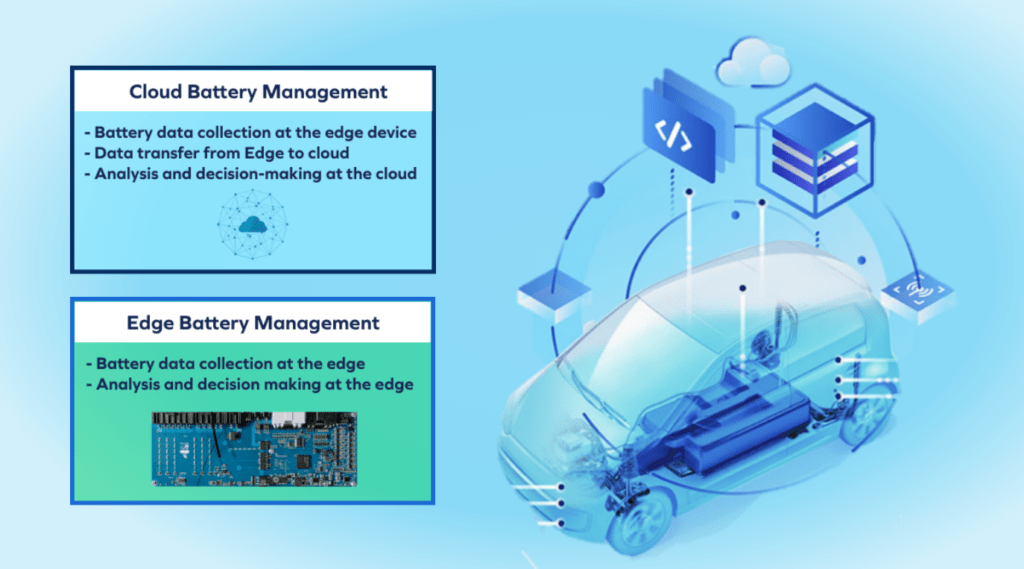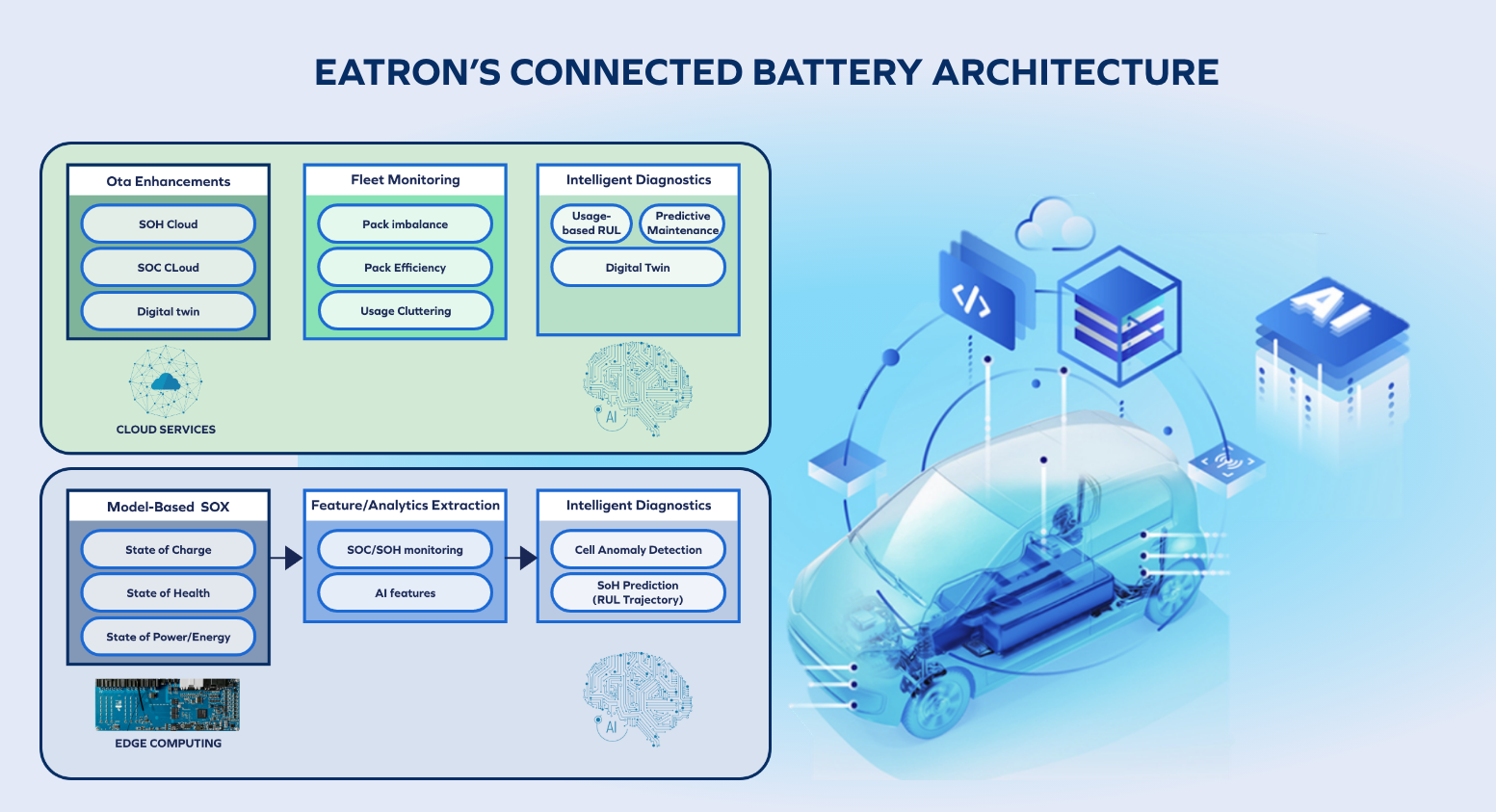OVERVIEW:
Efficient battery management is crucial in today’s electric vehicles, and key to achieving performance and longevity targets. Can Kurtulus, Eatron Technologies’ Chief Technical Officer, talks us through the two main approaches to battery management – edge and cloud – but also explains that there may be a hybrid solution that offers the benefits of both.
Battery Management at the Edge vs. in the Cloud. Which is best?
Battery management systems are often polarised into edge vs. cloud-based, but what if there’s a third way?
Battery management is a critical task for many devices, and is employed by many without us even realizing. However, it is particularly important for higher power devices such as electric vehicles, grid or house-level energy storage, and industrial equipment, and that makes effective battery management a key factor in achieving maximum performance and longevity.

Figure 1: Cloud Battery Management and Edge Battery Management
There are two main approaches to battery management today: edge and cloud. Let’s dive in to each one.
Edge battery management involves collecting battery data at the edge device and making decisions about battery management locally. This approach can offer lower latency, lower costs and better security, as the data does not need to be transferred to the cloud. However, edge battery management can be more complex to manage as keeping track of all the hardware and software variants, and keeping the batteries up to date with connectivity, is a significant undertaking. Edge devices need to have the necessary processing power and storage capacity to be able to deploy performant software features on them.
Cloud battery management involves collecting battery data at the edge device and sending it to the cloud for analysis and decision-making. This approach can offer scalability and cost-effectiveness, as the cloud can handle the processing and storage requirements for large numbers of devices. However, cloud battery management can have higher latency and security risks, as the data needs to be transferred to the cloud. In most cases, this introduces significantly higher costs as the necessary compute platform must be continuously available and able to support the whole fleet, while bandwidth costs can become excessive over time.
To summarize the pros and cons of each of the approaches let’s look at the table below:
| Pros: | Cons: | |
| Edge Battery Management | Lower latency: Edge computing can provide real-time processing for applications that require low latency.
Reduced costs: Edge computing can help to reduce costs by offloading some of the processing to edge devices. This will also reduce the amount of data that needs to be transferred to the cloud. Compute and bandwidth are the main expenses with cloud computing, so this is a win on both fronts. |
Complexity: Edge devices can be complex to manage. There might be a variety of edge devices and protocols deployed, and it can be difficult to keep track of everything and manage devices, hardware and software variants, etc.
|
| Cloud Battery Management | Scalability: Cloud computing is highly scalable. If there is a significant increase in fleet size, or demand for processing power due to newly introduced features or a fleet wide analysis need – cloud resources can be easily scaled up to meet the increased demand.
Cost-effectiveness for intermittent resource needs: Cloud computing can be cost-effective for applications that require a lot of processing power or access to substantial amounts of data intermittently. This is because cloud providers can amortize the cost of their infrastructure over many users which have variable demands. Global reach: Cloud computing has a global reach. This means that users can be supported in any part of the world with monitoring, OTA updates or fleet level analysis, etc. |
Latency: Cloud computing can have high latency. This is because data needs to be transferred to and from the cloud, which can take time and will sometimes bear significant bandwidth costs.
Connectivity needs: Always-on connectivity is required for certain functions relevant to operation and safety. Cost: Both compute and bandwidth are expensive.
|
Which of these approaches is best?
The best way forward is to use a hybrid approach that combines the strengths of both edge and cloud computing. This allows organizations to benefit from the best of both worlds, with low latency, competitive cost structure, good security, and scalability.
Some of the benefits of the hybrid edge-cloud approach:
- Improved performance: Edge devices can provide real-time processing for applications that require low latency and access to high-frequency data (e.g. most of the valuable diagnostics and prognostics functions).
- Reduced costs: A hybrid edge-cloud approach can help to significantly reduce the costs of cloud computing by offloading some of the processing to individual edge devices as well as reducing bandwidth costs by doing more of the processing locally.
- Enhanced security: Edge devices can help to improve security by keeping data closer to the source.
- Scalability: the cloud can easily fulfill all remaining computing and storage requirements, whilst providing the flexibility to scale the analysis and decision-making in the field without affecting the computation executed in the edge device.
Of course, there are also some challenges that need to be addressed in order to realize the full potential of a hybrid edge-cloud approach. :
- Data synchronization: Edge devices and cloud servers need to be synchronized to ensure that data is always up to date. A sufficient buffering strategy also needs to be deployed to maintain data continuity and guard against connectivity loss.
- Management: A hybrid edge-cloud approach can be complex to manage.
- Security: Edge devices need to be secure to protect sensitive data.
Conclusion:
To sum it up, the best way to look at the problem is to make use of both worlds with the right architecture:
- Do most of the heavy lifting and offer highly performant features (state estimation, diagnostics & prognostics, etc.) directly in the edge node (e.g., the BMS or a Zonal/Central compute unit). This will reduce bandwidth and connectivity needs as well as cloud compute costs.
- Do fleet level analyses and predictions in the cloud where you have access to data, usage and operating parameters from the whole fleet, allowing decision-making for each battery to include insights from the whole fleet.

Figure 2: Eatron’s BMS Edge-Cloud architecture
Management of all the devices at the edge (including hardware and software variant management), OTA, and security are the primary concerns and will require most of the effort of a connected battery management undertaking. For specific features that require a significant amount of battery and application expertise (e.g., SOX, intelligent diagnostics & prognostics), the most sensible path forward is to partner up with the right experts to make the most out of your batteries in the field by increasing their safety, performance, and lifetime.
Can Kurtulus, CTO at Eatron Technologies.
At Eatron we develop intelligent Battery Management Software solutions that can be deployed on both the edge and the cloud. If you are interested in learning more about these visit www.eatron.com or email info@eatron.com.
